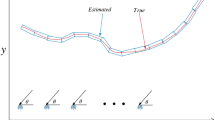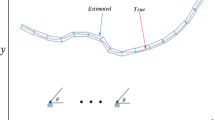Abstract
Tracking using only bearing measurements has elemental drawbacks like poor observability of the process and significant preliminary faults. Due to this reason, passive target tracking using bearing and frequency measurements is of good significance for developing a vigorous and swift-tracking system in a passive framework. Centered on the comparative analysis of traditional non-linear target tracking problems, a modern filtering technique called Doppler-Bearing Iterated Extended Kalman Filter (DB-IEKF) is projected in this correspondence. In this research, a new DB-IEKF framework for solving the problem of nonlinear filtering is presented with different optimization methods and compared with Doppler-Bearing Extended Kalman Filter (DBEKF). Besides, new optimization methods are also incorporated in this research to lessen the complexity in the optimization techniques, which reduces the computing complication. DB-IEKF has proved to be a vital tool for estimating the state of the target while tracking using nonlinear systems. The DB-IEKF, on the other hand, does not acquire optimal features that are comparable to those of the extended Kalman filter, and it may perform badly. By considering the DB-IEKF as an optimization problem, it is possible to enhance its efficiency and resilience in a variety of situations. DB-IEKF was carried out using different optimization methods in MATLAB software and proved the performance of each optimization technique concerning DB-IEKF and compared those methods with DBEKF.




Similar content being viewed by others
Data availability
Not applicable.
Code availability
Not applicable.
References
Nardone S, Lindgren AG, Gong K (1984) Fundamental properties and performance of conventional bearings-only target motion analysis. IEEE Trans Autom Control 29(9):775–787
Kumar DR, Rao SK, Raju KP (2017) Estimate-Merge-Technique-based algorithms to track an underwater moving target using towed array bearing-only measurements. Sādhanā 42(9):1617–1628
Gordon NJ, Salmond DJ, Smith AF (1993, April) Novel approach to nonlinear/non-Gaussian Bayesian state estimation. In: IEE proceedings F (radar and signal processing), vol 140, no 2. IET Digital Library, pp. 107-113
Aidala VJ (1979) Kalman Filter Behavior in Bearings-Only Tracking Applications. in IEEE Transactions on Aerospace and Electronic Systems, AES-15(1):29–39
Venkatachalam D (2021) An innovative vehicle surveillance framework using Internet of Things. Int J Innov Sci Eng Res 8(1):26–35
Satishkumar P, Saravana Murthi C (2019) Soft computing techniques for exhibiting progression constraints in manufacturing process. Int J Innov Sci Eng Res 6(1):1–6
Koteswara Rao S (2021) Bearings-only tracking: observer maneuver recommendation. IETE Journal of Research, 67(2):193–204
Chen Z, Xu W (2018) Joint passive detection and tracking of underwater acoustic target by beamforming-based bernoulli filter with multiple arrays. Sensors 18(11):4022
Divya G, Naga, Rao S, Koteswara (2021) Application of sigma point particle filter method for passive state estimation in underwater. Def Sci J 71(4):556–563
Koteswara Rao S, Kavitha Lakshmi M, Jahan, Kausar N, Divya G, Omkar Lakshmi Jagan B (2021) Acceptance criteria of bearings-only passive target tracking solution. IETE J Res. https://doi.org/10.1080/03772063.2021.1906769
Li P, Zhang X, Zhang W (2019) Direction of arrival estimation using two hydrophones: frequency diversity technique for passive sonar. Sensors 19(9):2001
Zhu C, Huang B, Zhou B, Su Y, Zhang E (2021) Adaptive model-parameter-free fault-tolerant trajectory tracking control for autonomous underwater vehicles. ISA Trans 114:57–71
Deng ZC, Yu X, Qin HD, Zhu ZB (2018) Adaptive kalman filter-based single-beacon underwater tracking with unknown effective sound velocity. Sensors 18(12):4339
Kalman RE (1960) A new approach to linear filtering and prediction problems. J Basic Eng 82:35–45
Fernandez AFG (2011) Detection and tracking of multiple targets using wireless sensor networks. Ph.D. dissertation, Universidad Politecnica de Madrid, Madrid, Spain
Shi W, Song S, Wu C, Chen CLP (2019) Multi pseudo Q-learning-based deterministic policy gradient for tracking control of autonomous underwater vehicles. IEEE Trans Neural Netw Learn Syst 30(12):3534–3546
Oh R, Shi Y, Choi JW (2021) A hybrid newton-raphson and particle swarm optimization method for target motion analysis by batch processing. Sensors 21(6):2033
Candy JV (2016) Bayesian signal processing: classical, modern, and particle filtering methods, vol 54. Wiley, Hoboken
Simon D (2006) Optimal state estimation: Kalman, H Infinity, and nonlinear approaches. Wiley, Hoboken
Kumar DR, Rao SK, Raju KP (2019) A novel estimation algorithm for torpedo tracking in undersea environment. J Cent South Univ 26(3):673–683
Jahan K, Koteswara Rao S (2019) Extended Kalman filter for bearings-only tracking. Int J Eng Adv Technol 8(6):637–640
Babu Sree Harsha P, Venkata Ratnam D (2018) Fuzzy logic-based adaptive extended Kalman filter algorithm for GNSS receivers. Def Sci J 68(6):560–565
Song T, Speyer J (1985) A stochastic analysis of a modified gain extended Kalman filter with applications to estimation with bearings only measurements. IEEE Trans Autom Control 30(10):940–949
Divya GN, Rao SK (2019) Application and comparison of bayesian framework algorithms for underwater state estimation. In: 2019 International Symposium on Ocean Technology (SYMPOL). IEEE, New York, pp 10-20
Garapati Vaishnavi B, Rao SK, Jahan K (2019) Underwater bearings-only tracking using particle filter. Int J Innov Technol Exploring Eng 8(5):451–455
Einicke GA, White LB (1999) Robust extended Kalman filtering. IEEE Trans Signal Process 47(9):2596–2599
Bar-Shalom Y, Li XR, Kirubarajan T (2004) Estimation with applications to tracking and navigation: theory algorithms and software. Wiley, Hoboken
g Luenberger D (2008) Linear and nonlinear programming. Springer Science+ Business Media, LLC
Jagan BO, Rao SK, Jahan K (2021) Unscented particle filter approach for underwater target tracking. Int J e-Collab (IJeC) 17(4):29–40
Bellaire RL, Kamen EW, Zabin SM (1995) New nonlinear iterated filter with applications to target tracking. Signal and data processing of small targets. Int Soc Opt Photon 2561:240–251
Chaaf A, Muthanna MSA (2021) Energy-efficient relay-based void hole prevention and repair in clustered multi-AUV underwater wireless sensor network. Secur Commun Netw 2021:9969605
Jagan OL, Koteswara Rao S (2020) Underwater surveillance in non-Gaussian noisy environment. Meas Control 53(1–2):250–261
Bell BM, Cathey FW (1993) The iterated Kalman filter update as a Gauss-Newton method. IEEE Trans Autom Control 38(2):294–297
Moriyama H, Yamashita N, Fukushima M (2003) The incremental Gauss-Newton algorithm with adaptive stepsize rule. Comput Optim Appl 26(2):107–141
Levenberg K (1944) A method for the solution of certain non-linear problems in least squares. Q Appl Math 2(2):164–168
Marquardt DW (1963) An algorithm for least-squares estimation of nonlinear parameters. J Soc Ind Appl Math 11(2):431–441
Skoglund MA, Hendeby G, Axehill D (2015, July) Extended Kalman filter modifications based on an optimization view point. In: 2015 18th International Conference on Information Fusion (Fusion). IEEE, New York, pp 1856-1861
Author information
Authors and Affiliations
Corresponding author
Ethics declarations
Conflict of interest
The authors have no conflicts of interest to declare that are relevant to the content of this article.
Additional information
Publisher’s Note
Springer Nature remains neutral with regard to jurisdictional claims in published maps and institutional affiliations.
Rights and permissions
About this article
Cite this article
Jagan, B.O.L., Rao, S.K. Evaluation of DB-IEKF Algorithm Using Optimization Methods for Underwater Passive Target Tracking. Mobile Netw Appl 27, 1070–1080 (2022). https://doi.org/10.1007/s11036-021-01862-x
Accepted:
Published:
Issue Date:
DOI: https://doi.org/10.1007/s11036-021-01862-x




